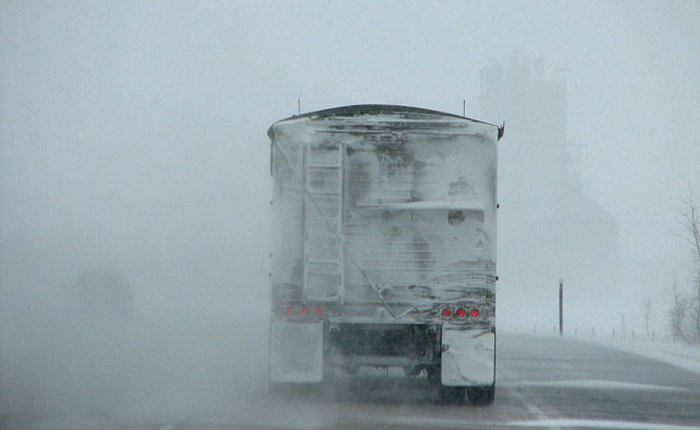
In March, a fatal accident between a saloon car and a trash truck occurred near Smoke Ranch Road in Las Vegas. The truck driver showed no signs of impairment while the saloon car driver did not survive.
This is the kind of damage that an 18-wheeler or other type of truck can cause.
And if that’s not enough, recent statistics show that truck accidents are a persistent problem in Las Vegas. Every year, hundreds of accidents involving commercial trucks result in personal injuries, costly repairs, and wrongful death claims.
Understanding the common causes of these accidents can help law enforcement agencies, personal injury law firms, and trucking companies devise measures to prevent them, and avoid the associated human and financial losses.
At Vegas Valley Injury Law, we help victims of trucking accidents that have suffered life-changing injuries and trauma as a result of such accidents.
We are committed to helping Las Vegas residents obtain compensation for the injury and property damage sustained as allowed under Nevada law.
In our experience, factors that lead to truck accidents often involve:
- Driver safety
- Equipment and vehicle maintenance
- Cargo-related concerns
- Environmental factors
Exploring these factors will prepare you for whenever you are involved in a truck accident and need compensation.
1) Fatigue and Distracted Driving

According to a National Academies Press report, driver fatigue and distracted driving remain the leading causes of commercial truck accidents nationwide.
Driver Fatigue
Driver fatigue often results from long hours of driving without taking sufficient breaks.
Fortunately, the Federal Motor Carrier Safety Administration (FMCA) has established regulations to address driver fatigue and distracted driving.
These regulations aim to prevent accidents caused by drivers who are excessively fatigued or distracted while operating commercial motor vehicles.
The Hours of Service (HOS) Regulations (49 CFR Part 395) govern the maximum allowable driving hours, mandatory rest breaks, and limits on work hours for commercial motor vehicle operators.
They include:
- Maximum driving time: For property-carrying drivers, the regulation sets a maximum of 11 hours of consecutive driving after 10 consecutive off-duty hours.
- Daily and weekly driving limits: The regulations specify limits on the total number of hours a driver can work and drive in a 24-hour period and over a 7 or 8-day period.
- Rest breaks: Drivers are required to take breaks during their shifts, including a 30-minute break after 8 hours of consecutive driving.
- Sleeper berth provision: The regulations provide guidelines for the use of the sleeper berth to satisfy the rest break and off-duty requirements.
However, some drivers ignore these regulations and continue to drive, leading to accidents caused by driver fatigue.
Vegas Valley Injury Law investigates driver fatigue by looking at travel logs and interviewing witnesses.
Distracted Driving
Distracted driving involves anything that takes a driver’s attention away from the task of driving.
The following regulations are used to limit distractions for truck drivers:
- Mobile phone use (49 CFR § 392.82): This regulation prohibits commercial motor vehicle drivers from using a hand-held mobile phone while operating their vehicles.
It also restricts the use of hands-free mobile devices if they require more than a single button push or involve reaching for the device. - Texting while driving: This regulation explicitly prohibits drivers from texting while operating a commercial motor vehicle.
- Distracted driving awareness: FMCSA encourages carriers and drivers to recognize and address the risks of distracted driving through training programs, safety campaigns, and other educational initiatives.
Carriers are expected to establish policies and practices that discourage distracted driving.
These regulations place responsibility on drivers and motor carriers to comply with the specific guidelines and standards to prevent driver fatigue and minimize distractions.
Vegas Valley Injury Law attourneys conduct an investigation to determine whether the driver was using their mobile device while driving.
Companies that employ truck drivers must ensure that their drivers obey these regulations by conducting regular checks on the drivers and logging their driving duration. By doing so, they can significantly reduce truck accidents caused by driver error.
Top Tip: To prevent truck accidents caused by fatigue and distractions, drivers must comply with the hours-of-service regulations and avoid mobile phone use while driving.
2) Equipment Malfunctions

Equipment malfunction is another common cause of commercial truck accidents in Las Vegas.
Take this Tampa Bay accident for example: Steve, his son, and grandson were on I-40 near Gallup, New Mexico when the front driver’s side tire blew out. Now, Steve and his family were on a pickup truck but this could also happen to a semi-truck.
Malfunctions can result from a variety of factors, including lack of maintenance, defective equipment, or improper repairs. Such malfunctions can lead to serious accidents that result in personal injury, property damage, and even wrongful death claims.
Common examples of equipment malfunctions include:
Brake Failure
When the braking system malfunctions, the truck driver may struggle to slow down or stop the vehicle, especially at high speeds or in emergencies, which can lead to catastrophic accidents.
Brake failure can occur due to worn-out brake pads, faulty brake lines, hydraulic system issues, or improper maintenance.
In such cases, the truck may collide with other vehicles, objects, or pedestrians, resulting in severe injuries or fatalities.
Tire Blowouts
A tire blowout refers to the sudden bursting or failure of a truck tire while in motion. This can cause the truck driver to lose control of the vehicle, leading to a potential collision or rollover.
Tire blowouts can occur due to factors such as inadequate tire maintenance, low tire pressure, overloading, worn-out tires, or manufacturing defects.
The sudden loss of control and the debris from the blown-out tire can create hazardous situations for other vehicles on the road as well.
Steering Problems
Steering problems can impair a truck driver’s ability to navigate and control the vehicle safely. Issues such as power steering failure, misalignment, loose steering components, or malfunctioning steering mechanisms can make it challenging to maneuver the truck effectively.
This can cause the truck to drift into other lanes, veer off the road, or show difficulty in responding to sudden obstacles or road conditions, leading to accidents.
Engine Failures
If the truck’s engine suddenly stalls, loses power, or experiences a mechanical malfunction, it can cause the driver to lose control or impede its ability to maintain a safe speed.
Engine failures can occur due to various reasons, including a lack of maintenance, fuel system issues, electrical problems, or manufacturing defects. Such failures can result in accidents if the truck becomes immobilized in a dangerous position or obstructs traffic flow.
These malfunctions can occur suddenly, leaving drivers with little time to react to avoid a collision.
Vegas Valley Injury Law helps victims of equipment malfunctions pursue compensation for damages. We investigate the accident to determine who was at fault and hold responsible parties accountable.
These guys are the best of the best. The settlement was not looking good after I had my accident, but after hiring this law firm they refused to stop until I got a fair settlement. They clearly worked hard to make sure I was properly represented.”
— Jeffrey H., Verified Client
It is important for trucking companies to properly maintain their vehicles and conduct regular inspections to identify any potential malfunctions before they cause an accident.
Proper maintenance and repairs can help prevent equipment malfunctions and reduce the risk of truck accidents.
Trucking companies should also ensure that their drivers are properly trained to identify and report any equipment deficiencies.
By taking these steps, trucking companies can help keep the roads safer for all drivers and prevent devastating accidents that can result in wrongful death claims.
The table below provides a comprehensive overview of equipment malfunctions in truck accidents, highlighting their causes and consequences.
| Equipment Malfunction | Causes | Consequences |
| Brake Failure | Worn-out brake pads, faulty brake lines, lack of maintenance | Collisions with other vehicles, objects, or pedestrians |
| Tire Blowouts | Inadequate tire maintenance, low tire pressure, overloading | Loss of control, potential collision or rollover |
| Steering Problems | Power steering failure, misalignment, loose steering components | Drifting into other lanes, veering off the road, accidents |
| Engine Failures | Lack of maintenance, fuel system issues, electrical problems | Loss of control, inability to maintain safe speed, accidents |
3) Overloading and Improper Loading

Overloading and improper loading of trucks can significantly contribute to accidents on the road.
That said, any truck that carries a load that exceeds its maximum safe capacity is overloaded.
Effects of Excess Weight
Reduced Stability
Overloading a truck can shift its center of gravity, making it more unstable and prone to tipping over, especially when turning or when sudden maneuvers are required.
This can result in rollover accidents, which are often severe and can involve multiple vehicles.
Braking Distance
An overloaded truck requires a longer distance to come to a complete stop. The additional weight puts more strain on the braking system, which may lead to brake failure or increased stopping distance.
This can result in rear-end collisions if the truck is unable to stop in time.
Learn how to avoid rear-end collisions with the video below:
Tire Failure
Excessive weight on a truck can cause increased stress on its tires.
Overloaded trucks are more likely to experience tire blowouts, which can lead to loss of control and accidents.
The problem is compounded by improper loading.
Effects of Improper Loading
A semi-truck overturned on the US-95 northbound onramp near Sunset Road. According to FOX5, the vehicle was suspected of carrying a load that was not secure. This caused its contents to shift and the trailer and tractor to overturn.
When cargo is not properly secured or balanced within the truck, it can lead to the following dangers:
- Shifting loads: Improperly secured cargo can shift or fall off the truck during transit. This can create hazardous situations for other vehicles on the road, as they may collide with the fallen cargo or swerve to avoid it, potentially causing accidents.
- Reduced visibility: If cargo is loaded in a way that obstructs the truck driver’s visibility, it can lead to blind spots or limited sight lines. This can make it difficult for the driver to maneuver safely, change lanes, or react to surrounding traffic, increasing the risk of collisions.
- Uneven weight distribution: Improperly balanced cargo can lead to uneven weight distribution within the truck. This can result in instability, especially during braking or sudden movements, making the truck more prone to accidents.
Victims of such accidents can depend on the services of Vegas Valley Injury law firm to help them pursue legal action.
I first hired Garrett when my son was in an accident. From the first phone call, we were able to move very quickly. The entire office staff was very courteous and we had our calls returned in hours, not days.”
— Lisa A., Verified Client
Weight Limit Regulations
Currently, truck size and weight standards are a blend of federal and state regulations and laws.
Federal laws state that the maximum gross vehicle weights limits are 80,000 pounds gross vehicle weight, 20,000 pounds on a single axle, and 34,000 pounds on a tandem axle group.
Here are some of the specific FMCSA regulations on different items that can prevent overloading or improper loading.
- Maximum Weight Limits (49 CFR § 393.71). This regulation establishes the maximum gross vehicle weight limits for different types of commercial motor vehicles based on their configuration and the specific regulations of each state.
- Cargo Securement (49 CFR § 393.100-393.136). These regulations outline the requirements for cargo securement, including the number and strength of tie-downs, methods of securement, and specific requirements for different types of cargo.
- Weight Distribution (49 CFR § 393.114). This regulation states that the weight on each axle must not exceed the manufacturer’s maximum load rating, and it establishes the maximum gross weight limits for different axle configurations.
Truck companies must ensure that cargo is properly secured and evenly distributed. Failure to adhere to these regulations may increase the risk of accidents and wrongful death claims.
Expert Tip: To prevent accidents caused by overloading and improper loading, trucking companies must comply with weight limit regulations and ensure proper weight distribution.
4) Poor Weather and Road Conditions

Poor weather conditions and hazardous road conditions significantly increase the likelihood of commercial truck accidents, leading to personal injury law firm cases, wrongful death claims, and serious damage to property.
Take a central Illinois case for example. A windstorm kicked up dangerous clouds of blinding dust from farm fields. This caused numerous crashes that involved between 40 to 60 cars and multiple semi-trucks.
8newsnow reported that at least six people died from that incident.
Las Vegas, being located in the Mojave Desert region, generally experiences a hot desert climate with relatively mild winters.
However, there are still weather and road conditions that can pose challenges for truck drivers and potentially lead to accidents.
Some poor weather and road conditions in Las Vegas that can contribute to truck accidents include:
Heavy Rain
Although rainfall in Las Vegas is generally low, heavy rain showers or thunderstorms can occur during certain times of the year. When rain is intense, it can create slick road surfaces, reduced visibility, and hydroplaning hazards.
Trucks may have difficulty maintaining traction and stopping distances may increase, increasing the risk of accidents.
Flash Floods
In desert regions like Las Vegas, heavy rainfall can lead to sudden flash floods.
Truck drivers may encounter flooded roads, debris, or reduced road stability during and after a flash flood, making it challenging to navigate safely.
Dust Storms
Dust storms, or haboobs, are relatively common in desert regions. These storms can generate strong winds that carry large amounts of dust and sand, reducing visibility to near zero.
Truck drivers caught in a dust storm may experience limited visibility, making it difficult to navigate or react to other vehicles or obstacles on the road.
High Winds
Las Vegas can experience strong gusty winds, particularly during certain seasons. High winds can cause instability for trucks, especially when carrying lighter loads or when driving on exposed stretches of highways or bridges.
Crosswinds can make it difficult to maintain control and stability, potentially leading to accidents.
Icy or Slippery Conditions
While Las Vegas doesn’t typically experience heavy snowfall, winter temperatures can occasionally drop below freezing, leading to icy or slippery road conditions, particularly during early morning hours.
These conditions can increase the risk of skidding, loss of control, and accidents, especially if trucks are not equipped with appropriate winter tires or drivers are not experienced in handling such conditions.
The solution to the dangers posed by poor weather and road conditions is for truck drivers to exercise caution and adjust their driving behavior in light of these conditions. They should slow down, keep a safe distance, and exercise patience while on the road.
Vegas Valley Injury Law firm is committed to representing any victims of a truck accident caused by poor weather or road conditions.
This is why we urge trucking companies to ensure that their vehicles are equipped with appropriate tire chains and other safety features. By doing so, they can limit the risk of accidents while ensuring that their drivers maintain a good driving record free from violations.
Learn More: 4 Top Considerations When Choosing a Truck Accident Attorney in Las Vegas
Preventive Measures for Las Vegas Truck Accidents
It is essential to address the various common causes of truck accidents in Las Vegas, including poor weather and road conditions.
Identifying the potential risks involved and taking the necessary precautions can help prevent accidents, save lives, and reduce the need for wrongful death claims and personal injury law firm cases.
With increased awareness, cooperation, and compliance with safety regulations, drivers can make Las Vegas roads safer for everyone.
Even more, those who are unfortunate enough to be involved in truck accidents can always seek compensation through Vegas Valley Injury Law.
I highly recommend Vegas Valley Injury Law to anyone who’s been hurt in an accident. Our attorney was incredibly helpful throughout the process. He was accessible day or night, and he fought hard to make the insurance company pay out for my injuries.”
— Nathan V., Verified Client
Related Reading: 5 Most Common Motorcycle Accident Injuries